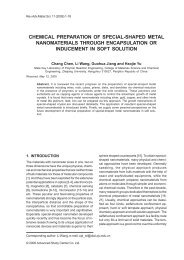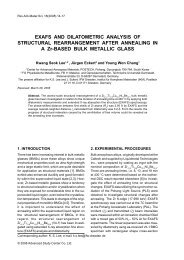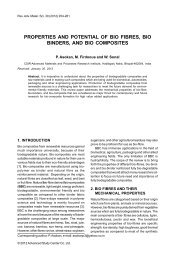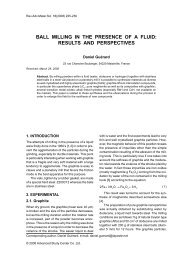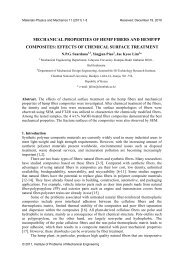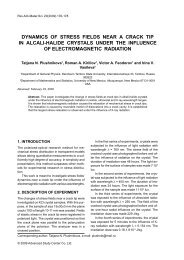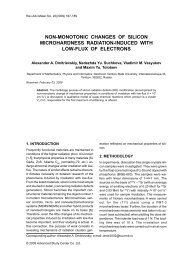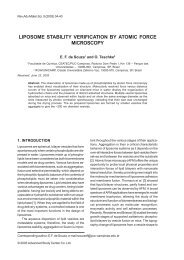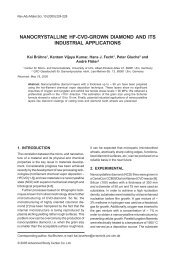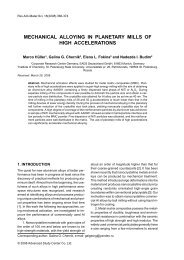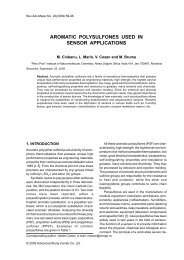surface pretreatment by phosphate conversion coatings – a review
surface pretreatment by phosphate conversion coatings – a review
surface pretreatment by phosphate conversion coatings – a review
Create successful ePaper yourself
Turn your PDF publications into a flip-book with our unique Google optimized e-Paper software.
132 T.S.N. Sankara Narayanan<br />
Table 1. Historical development of the phosphating process.<br />
Sl. Year/ Advancement made/process developed References<br />
No. Period<br />
1. 1906 Phosphating of iron and steel using phosphoric acid and iron filings 11<br />
2. 1908 Treatment of <strong>phosphate</strong> <strong>coatings</strong> with oxidizing agents to reduce 12<br />
process time<br />
3. 1909 Regeneration of the bath and formulation of zinc <strong>phosphate</strong> baths 13,14<br />
requiring high temperature <strong>–</strong> process time of one hour<br />
4. 1911 Formulation of manganese <strong>phosphate</strong> bath requiring high temperature - 15<br />
process time of 2-2.5 hours<br />
5. 1914 Parkerising process with maintenance of total acid to free acid ratio 16,17<br />
6. 1928 Recognition of <strong>phosphate</strong> coating as paint base 18,19<br />
7. 1929 Bonderizing process with the addition of Copper accelerator-coating 20<br />
time: 10 minutes to 1 hour<br />
8. 1933 Use of oxidizing agents like nitrate for acceleration <strong>–</strong> coating time: 21<br />
5 minutes<br />
9. 1934 Use of <strong>phosphate</strong> coating for cold working operations for metals 22<br />
10. 1937 Spray phosphating <strong>–</strong> phospating time: 60-90 seconds 23<br />
11. 1940 Development of non-coating <strong>phosphate</strong> process based on sodium 24<br />
or ammonium <strong>phosphate</strong>s<br />
12. 1940 Development of cold phosphating methods 25<br />
13. 1941 Phosphating of aluminium <strong>surface</strong>s using zinc <strong>phosphate</strong> and fluorides 26<br />
14. 1943 Use of disodium <strong>phosphate</strong> containing titanium as pre-dip before 27<br />
phosphating<br />
15. 1950’s Large scale application of manganese <strong>phosphate</strong> <strong>coatings</strong> as an oil 28<br />
retaining medium <strong>–</strong> for use on bearing or sliding <strong>surface</strong>s etc.<br />
16. 1960’s Use of special additives to control coating weight 29<br />
17. 1960’s Spray process at operating temperature of 25-30 °C 18,19<br />
18. 1970’s Improvement in coating quality, use of spray cleaners based on 18,19<br />
surfactant technology<br />
3.1. History and development of the<br />
phosphating process<br />
The use of <strong>phosphate</strong> <strong>coatings</strong> for protecting steel<br />
<strong>surface</strong>s has been known since the turn of the century<br />
and during this period the greater part of the<br />
World’s production of cars, refrigerators and furniture<br />
were treated this way. The first reliable record<br />
of <strong>phosphate</strong> <strong>coatings</strong> applied to prevent rusting of<br />
iron and steel is a British patent of 1869 granted to<br />
Ross [10]. In the method used <strong>by</strong> him, red hot iron<br />
articles were plunged into the phosphoric acid to<br />
prevent them from rusting. Since then numerous<br />
developments have taken place, of which the major<br />
developments are listed in Table 1.<br />
During the last 30 years, work has been concentrated<br />
mainly on improvements in quality, particularly<br />
to keep in pace with the recent changing<br />
needs of the organic finishing systems. Prominent<br />
among these are: (i) use of low temperature phosphating<br />
baths to overcome the energy crisis [30-<br />
32]; (ii) use of low zinc technology [18,19]; (iii) use<br />
of special additives in the phosphating bath [33-42];<br />
(iv) use of more than one heavy metal ions in existing<br />
composition-particularly tri-cation phosphating<br />
[43]; etc. New types of <strong>phosphate</strong> <strong>coatings</strong> such<br />
as tin, nickel and lead <strong>phosphate</strong> <strong>coatings</strong> have been<br />
introduced [44,45] besides the development of compositions<br />
for simultaneous phosphating of multiple<br />
metal substrates [46,47]. There has been a grow-



